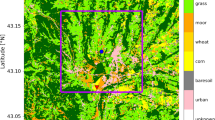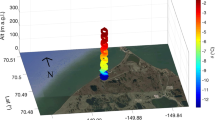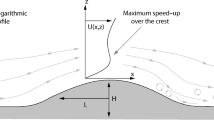Abstract
A remotely-piloted aircraft (RPA), equipped with a high resolution thermodynamic sensor package, was used to investigate physical processes during the morning transition of the atmospheric boundary layer over land. Experiments were conducted at a test site in heterogeneous terrain in south-west Germany on 5 days from June to September 2013 in an evolving shallow convective boundary layer, which then developed into a well-mixed layer later in the day. A combination of vertical profiling and constant-altitude profiling (CAP) at 100 m height above ground level was chosen as the measuring strategy throughout the experiment. The combination of flight strategies allows the application of mixed-layer scaling using the boundary-layer height \(z_i\), convective velocity scale \(w_*\) and convective temperature scale \(\theta _*\). The hypothesis that mixed-layer theory is valid during the whole transition was not confirmed for all parameters. A good agreement is found for temperature variances, especially in the upper half of the boundary layer, and the normalized heat-flux profile. The results were compared to a previous study with the helicopter-borne turbulence probe Helipod, and it was found that similar data quality can be achieved with the RPA. On all days, the CAP flight level was within the entrainment zone for a short time, and the horizontal variability of temperature and water vapour along the flight path is presented as an example of the inhomogeneity of layer interfaces in the boundary layer. The study serves as a case study of the possibilities and limitations with state-of-the-art RPA technology in micrometeorology.















Similar content being viewed by others
References
Angevine WM, Baltink HK, Bosveld FC (2001) Observations of the morning transition of the convective boundary layer. Boundary-Layer Meteorol 101:209–227
Bange J, Zittel P, Spieß T, Uhlenbrock J, Beyrich F (2006) A new method for the determination of area-averaged turbulent surface fluxes from low-level flights using inverse models. Boundary-Layer Meteorol 119:527–561
Bange J, Spieß T, van den Kroonenberg A (2007) Characteristics of the early-morning shallow convective boundary layer from helipod flights during STINHO-2. Theor Appl Climatol 90(1–2):113–126. doi:10.1007/s00704-006-0272-2
Bange J, Beyrich F, Engelbart DAM (2002) Airborne measurements of turbulent fluxes over heterogeneous terrain with helipod and do 128—error analysis and comparison with ground-based systems. In: 15th Conference on boundary layer and turbulence, American Meteorological Society, Wageningen, The Netherlands, pp 378–381
Beare R (2008) The role of shear in the morning transition boundary layer. Boundary-Layer Meteorol 129(3):395–410. doi:10.1007/s10546-008-9324-8
Bennett LJ, Weckwerth TM, Blyth AM, Geerts B, Miao Q, Richardson YP (2010) Observations of the evolution of the nocturnal and convective boundary layers and the structure of open-celled convection on 14 June 2002. Mon Weather Rev 138(7):2589–2607. doi:10.1175/2010MWR3200.1
Beyrich F, Leps JP, Mauder M, Bange J, Foken T, Huneke S, Lohse H, Lüdi A, Meijninger W, Mironov D, Weisensee U, Zittel P (2006) Area-averaged surface fluxes over the litfass region based on eddy-covariance measurements. Boundary-Layer Meteorol 121(1):33–65. doi:10.1007/s10546-006-9052-x
Bonin T, Chilson P, Zielke B, Fedorovich E (2013) Observations of the early evening boundary-layer transition using a small unmanned aerial system. Boundary-Layer Meteorol 146(1):119–132. doi:10.1007/s10546-012-9760-3
Brötz B, Eigenmann R, Dörnbrack A, Foken T, Wirth V (2014) Early-morning flow transition in a valley in low-mountain terrain under clear-sky conditions. Boundary-Layer Meteorol 152(1):45–63. doi:10.1007/s10546-014-9921-7
Deardorff JW (1974) Three-dimensional numerical study of the height and mean structure of a heated planetary boundary layer. Boundary-Layer Meteorol 7:81–106
Deardorff JW, Willis GE, Stockton BH (1980) Laboratory studies of the entrainment zone of a convectively mixed layer. J Fluid Mech 100:41–64. doi:10.1017/S0022112080001000
Edwards J, Basu S, Bosveld F, Holtslag A (2014) The impact of radiation on the GABLS3 large-eddy simulation through the night and during the morning transition. Boundary-Layer Meteorol 152(2):189–211. doi:10.1007/s10546-013-9895-x
Eigenmann R, Metzger S, Foken T (2009) Generation of free convection due to changes of the local circulation system. Atmos Chem Phys 9(21):8587–8600. doi:10.5194/acp-9-8587-2009
Foken T, Nappo C (2008) Micrometeorology, 1st edn. Springer, Berlin
Frank JM, Massman WJ, Ewers BE (2013) Underestimates of sensible heat flux due to vertical velocity measurement errors in non-orthogonal sonic anemometers. Agric For Meteorol 171–172:72–81. doi:10.1016/j.agrformet.2012.11.005
Garratt JR (1992) The atmospheric boundary layer. University Press, UK, 316 pp
Knuth SL, Cassano JJ (2014) Estimating sensible and latent heat fluxes using the integral method from in situ aircraft measurements. J Atmos Ocean Technol 31:1964–1981. doi:10.1175/JTECH-D-14-00008.1
Kochendorfer J, Meyers T, Frank J, Massman W, Heuer M (2012) How well can we measure the vertical wind speed? Implications for fluxes of energy and mass. Boundary-Layer Meteorol 145(2):383–398. doi:10.1007/s10546-012-9738-1
Lapworth A (2006) The morning transition of the nocturnal boundary layer. Boundary-Layer Meteorol 119(3):501–526. doi:10.1007/s10546-005-9046-0
Lenschow DH, Stankov BB, Mahrt L (1979) The rapid morning boundary-layer transition. J Atmos Sci 36:2108–2124
Lenschow DH, Stankov BB (1986) Length scales in the convective boundary layer. J Atmos Sci 43:1198–1209
Martin S, Beyrich F, Bange J (2014) Observing entrainment processes using a small unmanned aerial vehicle: a feasibility study. Boundary-Layer Meteorol 150(3):449–467. doi:10.1007/s10546-013-9880-4
Martin S, Bange J (2014) The influence of aircraft speed variations on sensible heat-flux measurements by different airborne systems. Boundary-Layer Meteorol 150(1):153–166. doi:10.1007/s10546-013-9853-7
Reineman BD, Lenain L, Statom NM, Melville WK (2013) Development and testing of instrumentation for UAV-based flux measurements within terrestrial and marine atmospheric boundary layers. J Atmos Ocean Technol 30(7):1295–1319. doi:10.1175/JTECH-D-12-00176.1
Sorbjan Z (1989) Structure of the atmospheric boundary layer. Prentice Hall Advanced Reference Series: Physical and Life Sciences. Prentice Hall, New Jersey, 317 pp
Sorbjan Z (1995) Toward evaluation of heat fluxes in the convective boundary layer. J Appl Meteorol 34:1092–1098
Sorbjan Z (2007) A numerical study of daily transitions in the convective boundary layer. Boundary-Layer Meteorol 123(3):365–383. doi:10.1007/s10546-006-9147-4
Stull R (1988) An introduction to boundary layer meteorology. Kluwer Academic Publishers, Dordrecht, 666 pp
United States Committee (1976) U.S. standard atmosphere, 1976. National Oceanic and Amospheric Administration, Washington, DC
van den Kroonenberg AC, Martin T, Buschmann M, Bange J, Vörsmann P (2008) Measuring the wind vector using the autonomous mini aerial vehicle \({{\rm M}^{2} {\rm AV}}\). J Atmos Ocean Technol 25:1969–1982
Wildmann N, Mauz M, Bange J (2013) Two fast temperature sensors for probing of the atmospheric boundary layer using small remotely piloted aircraft (RPA). Atmos Meas Tech 6(8):2101–2113. doi:10.5194/amt-6-2101-2013
Wildmann N, Hofsäß M, Weimer F, Joos A, Bange J (2014) Masc—a small remotely piloted aircraft (RPA) for wind energy research. Adv Sci Res 11:55–61. doi:10.5194/asr-11-55-2014
Wildmann N, Kaufmann F, Bange J (2014) An inverse-modelling approach for frequency response correction of capacitive humidity sensors in ABL research with small remotely piloted aircraft (RPA). Atmos Meas Tech 7(9):3059–3069. doi:10.5194/amt-7-3059-2014
Wildmann N, Ravi S, Bange J (2014) Towards higher accuracy and better frequency response with standard multi-hole probes in turbulence measurement with remotely piloted aircraft (RPA). Atmos Meas Tech 7(4):1027–1041. doi:10.5194/amt-7-1027-2014
Acknowledgments
We thank all those who helped during the experiments by supporting the ground crew in the field or with fruitful discussions to improve the quality of the data evaluation. Special thanks go to Roland Dörsam, who provided measurements from his weather station close to the measurement site.
Author information
Authors and Affiliations
Corresponding author
Appendix: Uncertainty Estimation of Surface Heat Fluxes
Appendix: Uncertainty Estimation of Surface Heat Fluxes
The uncertainty of the estimated surface heat flux \(H_0\) can be evaluated theoretically. We consider the uncertainties \(\sigma _B = 0.1\), \(\sigma _{z_i} = 20\,\text{ m }\), \(\sigma _{\dot{\theta }} = 1\times 10^{-4}\,\hbox {K\,s}^{-1}\), and apply Gaussian error propagation to Eq. 8,
with the boundary conditions \(B = 0.68\), \(z_i = 200\) m, \(\dot{\theta } = 1\times 10^{-3}\,\hbox {K\,s}^{-1}\), \(\rho = 1.18\,\hbox {kg\,m}^{-3}\) and \(c_\mathrm{p} = 1006\,\hbox {J\,kg}^{-1}\,\text{ K }^{-1}\). The result is an uncertainty of \(\sigma _H=\) 33 W m\(^{-2}\) for a surface heat flux of 161 W m\(^{-2}\), which is approximately 20 %.
Rights and permissions
About this article
Cite this article
Wildmann, N., Rau, G.A. & Bange, J. Observations of the Early Morning Boundary-Layer Transition with Small Remotely-Piloted Aircraft. Boundary-Layer Meteorol 157, 345–373 (2015). https://doi.org/10.1007/s10546-015-0059-z
Received:
Accepted:
Published:
Issue Date:
DOI: https://doi.org/10.1007/s10546-015-0059-z




